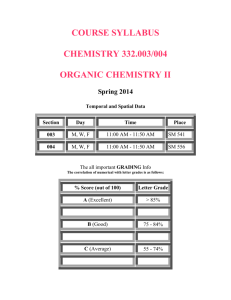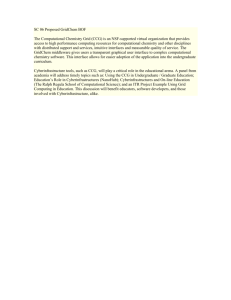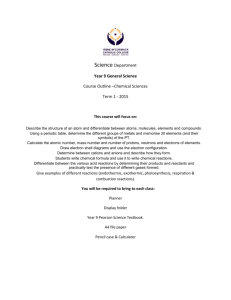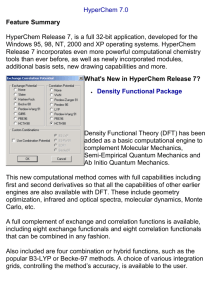Computational Chemistry
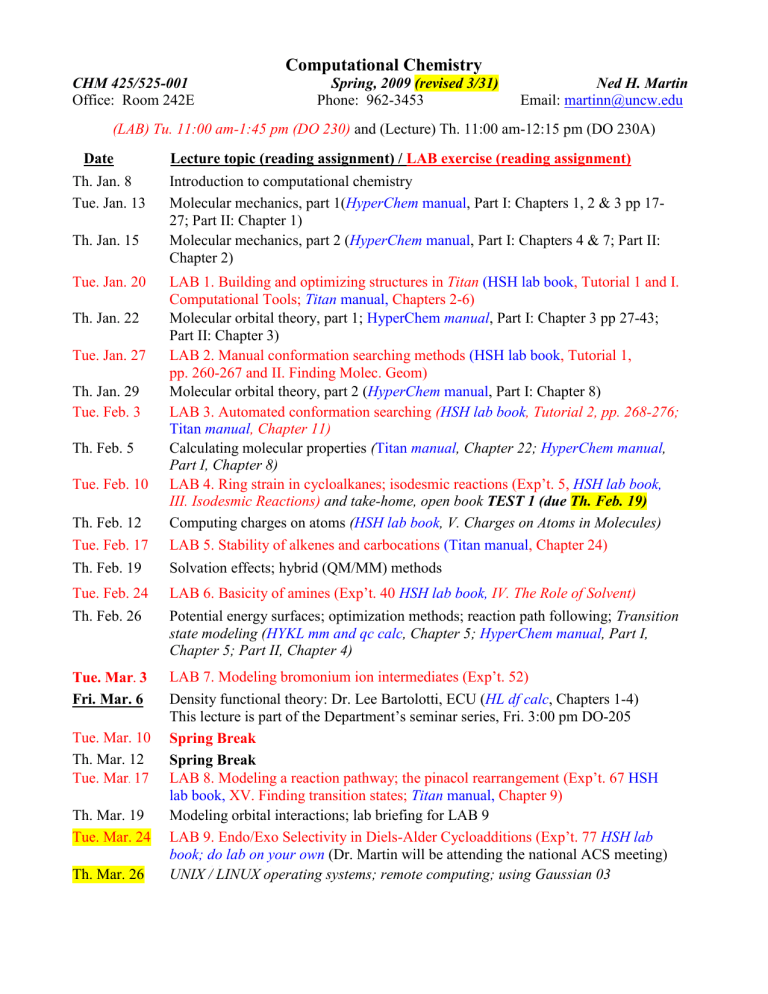
Computational Chemistry
CHM 425/525-001 Spring, 2009 (revised 3/31) Ned H. Martin
Office: Room 242E Phone: 962-3453 Email: martinn@uncw.edu
(LAB) Tu. 11:00 am-1:45 pm (DO 230) and (Lecture) Th. 11:00 am-12:15 pm (DO 230A)
Date
Th. Jan. 8
Lecture topic (reading assignment) / LAB exercise (reading assignment)
Introduction to computational chemistry
Tue. Jan. 13 Molecular mechanics, part 1( HyperChem manual , Part I: Chapters 1, 2 & 3 pp 17-
27; Part II: Chapter 1)
Th. Jan. 15 Molecular mechanics, part 2 ( HyperChem manual , Part I: Chapters 4 & 7; Part II:
Chapter 2)
Tue. Jan. 20 LAB 1. Building and optimizing structures in Titan (HSH lab book , Tutorial 1 and I.
Computational Tools; Titan manual, Chapters 2-6)
Th. Jan. 22 Molecular orbital theory, part 1; HyperChem manual , Part I: Chapter 3 pp 27-43;
Part II: Chapter 3)
Tue. Jan. 27 LAB 2. Manual conformation searching methods (HSH lab book , Tutorial 1, pp. 260-267 and II. Finding Molec. Geom)
Th. Jan. 29 Molecular orbital theory, part 2 ( HyperChem manual , Part I: Chapter 8)
Tue. Feb. 3 LAB 3. Automated conformation searching ( HSH lab book , Tutorial 2, pp. 268-276;
Titan manual , Chapter 11)
Th. Feb. 5 Calculating molecular properties
Part I, Chapter 8)
( Titan manual , Chapter 22; HyperChem manual ,
Tue. Feb. 10 LAB 4. Ring strain in cycloalkanes; isodesmic reactions (Exp’t. 5, HSH lab book,
III. Isodesmic Reactions) and take-home, open book TEST 1 (due Th. Feb. 19)
Th. Feb. 12 Computing charges on atoms ( HSH lab book , V. Charges on Atoms in Molecules)
Tue. Feb. 17 LAB 5. Stability of alkenes and carbocations (Titan manual , Chapter 24)
Th. Feb. 19 Solvation effects; hybrid (QM/MM) methods
Tue. Feb. 24 LAB 6. Basicity of amines (Exp’t. 40 HSH lab book, IV. The Role of Solvent)
Th. Feb. 26 Potential energy surfaces; optimization methods; reaction path following; Transition state modeling ( HYKL mm and qc calc , Chapter 5; HyperChem manual , Part I,
Chapter 5; Part II, Chapter 4)
Tue. Mar
.
3 LAB 7. Modeling bromonium ion intermediates (Exp’t. 52)
state modeling ( HYKL mm and qc calc , Chapter 5; HyperChem manual , Part I,
Fri. Mar. 6 Density functional theory: Dr. Lee Bartolotti, ECU ( HL df calc , Chapters 1-4)
This lecture is part of the Department’s seminar series, Fri. 3:00 pm DO-205
Tue. Mar. 10 Spring Break
Th. Mar. 12 Spring Break
Tue. Mar
.
17 LAB 8. Modeling a reaction pathway; the pinacol rearrangement (Exp’t. 67 HSH lab book, XV. Finding transition states; Titan manual, Chapter 9)
Th. Mar. 19 Modeling orbital interactions; lab briefing for LAB 9
Tue. Mar. 24 LAB 9. Endo/Exo Selectivity in Diels-Alder Cycloadditions (Exp’t. 77 HSH lab book; do lab on your own (Dr. Martin will be attending the national ACS meeting)
Th. Mar. 26
M-W this week) )
)
Tue. Mar. 31 LAB 11. Classical vs. Non-Classical Carbocations; NMR shift and charge calculations using Gaussian 03 on a remote computer (lab counts double)
Th. Apr. 2 TEST 2
Tue. Apr. 7 LAB 10. Modeling the Relative Acidities of Substituted Phenols ( HSH lab book, IX.
Graphical Models and Graphical Modeling)
Th. Apr. 9 No Classes
Tue. Apr. 14
LAB 11 cont’d
Gaussian 03 on a remote computer
Th. Apr. 16
Tue. Apr. 21
Quantitative Structure-Activity Relationships (QSAR)
Oral (PowerPoint) Reports on LAB 11. NMR shift and charge calculations and
Research Examples of Computational Chemistry
WWW computational chemistry resources; modeling biomolecules Th. Apr. 23
Tue. May 5 FINAL EXAM 11:30 am – 2:30 pm
LAB reports are to be written in MSWord or (preferably) Excel and submitted as an attachment to email to martinn@uncw.edu
no later than one week after the lab is scheduled. Ongoing efforts should be made to improve the readability/utility and appearance of the reports.
Grading:
15 Basic computational chemistry skills 60 points
2 Tests 200 points
11 Computational lab reports (#11 counts double) 120 points
Final Exam (comprehensive) 120 points
Total 500 points
(Graduate students must also complete a computational chemistry project with a written report)
90% = A 80% = B 70% = C 60% = D
Texts: (to be loaned to students by instructor; no text needs to be purchased)
HyperChem Computational Chemistry ( HyperChem manual )
TITAN Tutorial and User’s Guide ( Titan manual ), Wavefunction, Schrodinger, 1999
A Laboratory Book of Computational Organic Chemistry , ( HSH lab book ), Warren J.
Hehre, Alan J. Shusterman, W. Wayne Huang, Wavefunction, Irvine, 1996.
A Brief Guide to Molecular Mechanics and Quantum Chemical Calculations , ( HYKL mm and qc calc ) Warren J. Hehre, Jianguo Yu, Philip E. Klunzinger, Liang Lou, Wavefunction,
Irvine, 1997.
A Guide to Density Functional Calculations in Spartan , ( HL df calc ) Warren J. Hehre, Liang
Lou, Wavefunction, Irvine, 1997.
Additional Resources (available in Randall Library):
Introduction to Computational Chemistry , Frank Jensen, Wiley, Chichester, 1999
Molecular Modeling: Perspectives and Applications , Andrew R. Leach, Addison Wesley
Longman, Harlow, 1996
A Handbook of Computational Chemistry, Tim Clark, Wiley-Interscience, NY, 1985
Encyclopedia of Computational Chemistry, (Ref QD 39.3.) Ed. Paul v. R. Schleyer, Wiley,
Chichester, 1998




